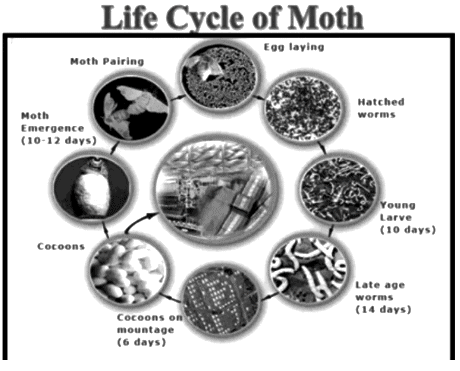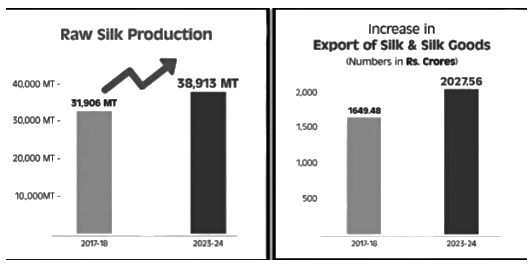UPSC Exam > UPSC Notes > PIB (Press Information Bureau) Summary > PIB Summary- 12th April, 2025
PIB Summary- 12th April, 2025 | PIB (Press Information Bureau) Summary - UPSC PDF Download
The Magic of Indian Silk
Context
The article discusses the significance of sericulture in India, focusing on silk production’s economic role and its contribution to rural employment.
Introduction to Silk and Its Significance
- Silk is an important part of India’s history, tradition, and art.
- Indian silk sarees, such as those from Kanchipuram and Bhagalpur, reflect the country’s rich culture.
- The craftsmanship behind these sarees is passed down through generations of artisans.
Sericulture Process
- Sericulture refers to farming silkworms to produce silk.
- Silkworms are raised on leaves from mulberry, oak, castor, and arjun trees.
- After about a month, silkworms spin cocoons which are boiled to extract silk threads.
- These threads are twisted into yarn and woven into fabric, turning simple silkworms into valuable silk.

Economic Role of Silk in India
- India is the second-largest producer and the largest consumer of silk globally.
- Mulberry silk is produced in several states like Karnataka, Andhra Pradesh, and Tamil Nadu.
- Non-mulberry silk, also known as Vanya silk, is produced in states like Jharkhand and Orissa.
- Silk production supports rural employment and contributes to foreign exchange.
- Silk accounts for only 0.2% of the world’s textile production but plays a vital role in economic development.
Growth of India’s Silk Market
- India’s silk production has steadily increased, from 31,906 MT in 2017-18 to 38,913 MT in 2023-24.
- The area of mulberry plantations grew from 223,926 ha in 2017-18 to 263,352 ha in 2023-24.
- Silk exports increased from ₹1,649.48 crores in 2017-18 to ₹2,027.56 crores in 2023-24.

Government Schemes Supporting Silk Development
- The Silk Samagra Scheme aims to improve silk production by enhancing quality and productivity.
- The scheme includes research, training, technology transfer, seed organizations, market development, and quality certification.
- Silk Samagra-2, with a budget of ₹4,679.85 crores, extends these efforts.
- Other supporting schemes include the Raw Material Supply Scheme and the National Handloom Development Programme, which help weavers and silk fabric producers.
- The Scheme for Capacity Building in the Textile Sector, SAMARTH, aims to train 3 lakh people.
Conclusion
- The growth of India’s silk industry is supported by various government schemes.
- These efforts help farmers, weavers, and rural families, ensuring India’s silk industry thrives.
- With further support, India can become a global leader in silk while preserving its traditional silk-making practices.
Question for PIB Summary- 12th April, 2025Try yourself: What is sericulture?View Solution
The document PIB Summary- 12th April, 2025 | PIB (Press Information Bureau) Summary - UPSC is a part of the UPSC Course PIB (Press Information Bureau) Summary.
All you need of UPSC at this link: UPSC
FAQs on PIB Summary- 12th April, 2025 - PIB (Press Information Bureau) Summary - UPSC
| 1. What are the key features of Indian silk that make it unique? |  |
Ans. Indian silk is renowned for its luxurious texture, vibrant colors, and intricate designs. The key features include its natural sheen, durability, and the ability to hold dyes exceptionally well, resulting in rich and vibrant colors. Different types of Indian silk, such as Mulberry, Tussar, and Muga, each have unique characteristics and production methods that contribute to their distinct qualities.
| 2. How does the production of Indian silk impact the economy? |  |
Ans. The production of Indian silk significantly contributes to the rural economy by providing employment to millions of farmers and artisans. It supports sustainable agriculture and promotes traditional craftsmanship, thereby enhancing livelihoods. Additionally, the silk industry contributes to export revenues, boosting the overall economic growth of the country.
| 3. What initiatives has the Indian government taken to promote silk production? |  |
Ans. The Indian government has launched various initiatives to promote silk production, including the National Sericulture Mission, which aims to enhance silk production, increase the income of farmers, and promote sustainable practices. Additionally, the government provides financial assistance, training programs, and technology transfer to improve the quality and productivity of silk production.
| 4. What are the environmental considerations associated with silk production in India? |  |
Ans. Silk production in India involves several environmental considerations, including the use of pesticides and water resources. Sustainable practices, such as organic sericulture and water conservation techniques, are being promoted to mitigate the negative environmental impact. Moreover, initiatives are focusing on preserving biodiversity and supporting eco-friendly farming methods to ensure a sustainable silk industry.
| 5. How does Indian silk compare to silk from other countries? |  |
Ans. Indian silk is often considered superior to silk from other countries due to its diverse varieties and rich cultural heritage. While countries like China and Thailand also produce silk, Indian silk is distinguished by its unique weaving techniques, traditional motifs, and organic production methods. The craftsmanship involved in Indian silk weaving, especially in regions like Varanasi and Kanchipuram, adds to its global appeal and prestige.
Related Searches
















